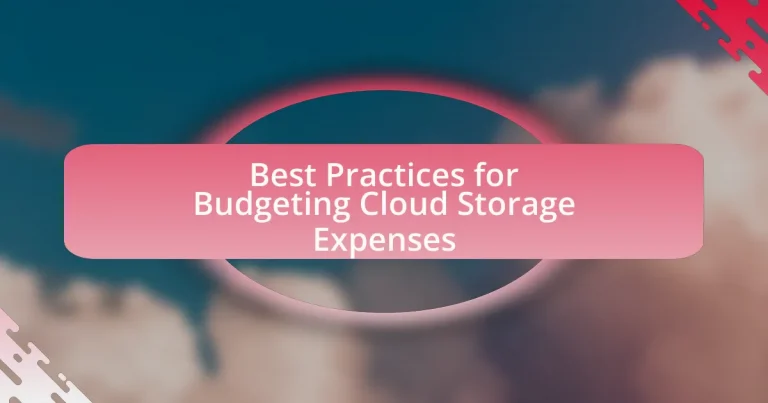The article focuses on best practices for budgeting cloud storage expenses, emphasizing the importance of assessing storage needs, selecting appropriate pricing models, and regularly monitoring usage. Key strategies include optimizing data management, implementing tiered storage solutions, and utilizing cost management tools to track expenses effectively. The article also highlights factors influencing cloud storage costs, such as data transfer rates and access frequency, while providing insights into common pitfalls to avoid and practical tips for managing expenses. By following these guidelines, organizations can enhance their budgeting accuracy and potentially save up to 30% on cloud storage costs.
What are the Best Practices for Budgeting Cloud Storage Expenses?
The best practices for budgeting cloud storage expenses include assessing storage needs, selecting the right pricing model, monitoring usage regularly, and optimizing data management. Assessing storage needs involves evaluating current and future data requirements to avoid over-provisioning. Choosing the right pricing model, such as pay-as-you-go or reserved instances, can significantly impact costs based on usage patterns. Regular monitoring of usage helps identify trends and potential savings, while optimizing data management, including data lifecycle policies and archiving, can reduce unnecessary storage expenses. These practices are supported by industry reports indicating that organizations can save up to 30% on cloud costs through effective management and monitoring strategies.
How can organizations effectively plan their cloud storage budgets?
Organizations can effectively plan their cloud storage budgets by conducting a thorough assessment of their current and future storage needs. This involves analyzing data growth trends, understanding usage patterns, and evaluating the types of data being stored to determine the appropriate storage solutions. For instance, a study by Gartner indicates that organizations can save up to 30% on cloud storage costs by optimizing their storage tiers based on data access frequency. Additionally, implementing cost monitoring tools and regularly reviewing cloud service provider pricing models can help organizations adjust their budgets in real-time, ensuring they only pay for what they use.
What factors should be considered when estimating cloud storage costs?
When estimating cloud storage costs, several key factors must be considered, including storage capacity, data transfer rates, access frequency, and additional services. Storage capacity directly influences the base cost, as providers typically charge per gigabyte stored. Data transfer rates affect costs associated with uploading and downloading data, with many providers imposing fees for outbound data transfer. Access frequency is crucial, as frequently accessed data may incur higher costs compared to infrequently accessed data, which can often be stored at a lower rate. Additionally, extra services such as data redundancy, backup solutions, and security features can add to the overall expense. Understanding these factors allows for a more accurate estimation of cloud storage costs.
How do usage patterns influence budgeting for cloud storage?
Usage patterns significantly influence budgeting for cloud storage by determining the amount of storage needed and the associated costs. Organizations that analyze their data usage trends can forecast storage requirements more accurately, allowing for optimized spending. For instance, a company that experiences seasonal spikes in data usage may budget for additional storage during peak times, while a steady usage pattern might lead to a more consistent budget allocation. Additionally, understanding usage patterns helps in selecting the right pricing model, such as pay-as-you-go versus reserved capacity, which can lead to cost savings. According to a report by Gartner, organizations that effectively monitor and adjust their cloud storage based on usage patterns can reduce costs by up to 30%.
Why is it important to monitor cloud storage expenses regularly?
Monitoring cloud storage expenses regularly is crucial to prevent unexpected costs and optimize budget allocation. Regular monitoring allows organizations to identify usage patterns, detect anomalies, and adjust resources accordingly, ensuring that they only pay for what they need. According to a report by Gartner, organizations can save up to 30% on cloud costs by implementing effective monitoring and management practices. This proactive approach not only helps in maintaining financial control but also enhances overall resource efficiency.
What tools can assist in tracking cloud storage costs?
Tools that can assist in tracking cloud storage costs include cloud cost management platforms such as CloudHealth, CloudCheckr, and AWS Cost Explorer. These tools provide detailed insights into usage patterns, cost allocation, and budget forecasting, enabling organizations to optimize their cloud spending. For instance, CloudHealth offers analytics that help identify underutilized resources, while AWS Cost Explorer allows users to visualize their spending trends over time. Such functionalities are essential for effective budgeting and cost management in cloud storage environments.
How can organizations identify unexpected expenses in cloud storage?
Organizations can identify unexpected expenses in cloud storage by implementing detailed monitoring and analytics tools that track usage patterns and costs. These tools provide insights into resource consumption, allowing organizations to detect anomalies such as sudden spikes in data transfer or storage usage that deviate from established baselines. For instance, a study by Gartner highlights that organizations using cloud cost management tools can reduce their cloud spending by up to 30% by identifying and addressing unexpected charges. Regular audits of cloud service invoices and usage reports further enable organizations to pinpoint discrepancies and optimize their cloud storage strategies effectively.
What strategies can optimize cloud storage budgeting?
To optimize cloud storage budgeting, organizations should implement strategies such as tiered storage management, regular usage audits, and automated cost monitoring. Tiered storage management allows businesses to allocate data to different storage classes based on access frequency, reducing costs by utilizing cheaper storage options for infrequently accessed data. Regular usage audits help identify underutilized resources, enabling organizations to eliminate unnecessary expenses. Automated cost monitoring tools provide real-time insights into spending patterns, allowing for timely adjustments to avoid budget overruns. These strategies collectively enhance financial efficiency in cloud storage management.
How can organizations choose the right cloud storage pricing model?
Organizations can choose the right cloud storage pricing model by assessing their specific storage needs, usage patterns, and budget constraints. Evaluating factors such as data access frequency, required performance levels, and compliance requirements helps in selecting a model that aligns with operational demands. For instance, organizations with infrequent access to data may benefit from a lower-cost, tiered storage option, while those needing rapid access might opt for a premium model. Additionally, analyzing historical usage data can provide insights into cost-effectiveness, enabling organizations to predict future storage needs accurately. This approach ensures that the chosen pricing model not only meets current requirements but also accommodates future growth, ultimately optimizing cloud storage expenses.
What are the differences between pay-as-you-go and reserved pricing?
Pay-as-you-go pricing allows users to pay only for the resources they consume, while reserved pricing requires users to commit to a specific amount of resources for a set period, typically offering a discount for this commitment. Pay-as-you-go is flexible and ideal for variable workloads, as users can scale resources up or down based on demand. In contrast, reserved pricing provides cost savings for predictable workloads, as users can save up to 70% compared to pay-as-you-go rates by committing to long-term usage. This pricing model is beneficial for organizations with stable resource needs, allowing for better budgeting and financial planning.
How can hybrid cloud solutions impact budgeting strategies?
Hybrid cloud solutions can significantly impact budgeting strategies by providing flexibility in resource allocation and cost management. Organizations can optimize their spending by utilizing on-premises infrastructure for predictable workloads while leveraging public cloud resources for variable demand, thus avoiding over-provisioning. According to a report by Gartner, businesses can save up to 30% on IT costs by adopting hybrid cloud models, as they allow for more efficient use of resources and better alignment of expenses with actual usage. This strategic approach enables companies to adjust their budgets dynamically based on real-time data and changing business needs, ultimately leading to more effective financial planning.
What role does data management play in budgeting for cloud storage?
Data management is crucial in budgeting for cloud storage as it directly influences cost efficiency and resource allocation. Effective data management practices, such as data classification and lifecycle management, help organizations identify which data is essential to retain and which can be archived or deleted, thereby optimizing storage costs. For instance, a study by Gartner indicates that organizations can save up to 30% on cloud storage expenses by implementing proper data management strategies. This demonstrates that strategic data oversight not only reduces unnecessary storage costs but also enhances overall budget accuracy and forecasting for cloud services.
How can data lifecycle management reduce cloud storage costs?
Data lifecycle management can reduce cloud storage costs by optimizing data storage based on its relevance and usage frequency. By implementing policies that automatically move less frequently accessed data to lower-cost storage tiers or delete obsolete data, organizations can significantly decrease their overall storage expenses. For instance, a study by Gartner indicates that effective data lifecycle management can reduce storage costs by up to 30% by ensuring that only necessary data is retained in expensive, high-performance storage solutions.
What are the best practices for data archiving and deletion?
The best practices for data archiving and deletion include implementing a clear data retention policy, regularly reviewing and classifying data, utilizing automated archiving solutions, and ensuring compliance with legal and regulatory requirements. A clear data retention policy defines how long different types of data should be kept, which helps in managing storage costs effectively. Regularly reviewing and classifying data allows organizations to identify redundant or obsolete information that can be deleted, thereby optimizing storage usage. Automated archiving solutions streamline the process of moving infrequently accessed data to lower-cost storage options, which is essential for budgeting cloud storage expenses. Compliance with legal and regulatory requirements ensures that data is retained or deleted according to applicable laws, reducing the risk of penalties.
What common pitfalls should be avoided in cloud storage budgeting?
Common pitfalls to avoid in cloud storage budgeting include underestimating data growth, neglecting hidden costs, and failing to monitor usage. Underestimating data growth can lead to unexpected expenses as storage needs increase; for instance, organizations often experience a 30% annual growth in data. Neglecting hidden costs, such as data transfer fees and retrieval charges, can inflate budgets significantly; studies show that these costs can account for up to 20% of total cloud expenses. Lastly, failing to monitor usage can result in over-provisioning or unused resources, which can waste up to 35% of cloud budgets.
How can organizations prevent overspending on cloud storage?
Organizations can prevent overspending on cloud storage by implementing strict monitoring and management practices. Regularly reviewing storage usage and costs allows organizations to identify underutilized resources and eliminate unnecessary expenses. Utilizing automated tools for cost management can provide real-time insights into spending patterns, enabling proactive adjustments. Additionally, setting clear budgets and usage limits for different departments can help control costs effectively. According to a report by Gartner, organizations that actively manage their cloud resources can reduce costs by up to 30%.
What are the risks of underestimating cloud storage needs?
Underestimating cloud storage needs can lead to significant operational risks, including data loss, increased costs, and performance issues. When organizations fail to accurately assess their storage requirements, they may experience unexpected data shortages, forcing them to scramble for additional resources, which can result in downtime and lost productivity. According to a study by Gartner, 70% of organizations that underestimate their cloud storage needs face unplanned expenses, often exceeding their initial budget by 30% or more. This miscalculation can also lead to inadequate data backup and recovery solutions, increasing the risk of data breaches and compliance violations.
How can lack of visibility lead to budgeting issues?
Lack of visibility can lead to budgeting issues by preventing organizations from accurately tracking and forecasting their cloud storage expenses. When organizations do not have clear insights into their usage patterns, they may underestimate costs, leading to budget overruns. For instance, a study by Gartner indicates that 70% of organizations overspend on cloud services due to a lack of visibility into their usage and costs. This lack of awareness can result in unexpected charges and hinder effective financial planning, ultimately impacting the overall budget management process.
What are the best practices for forecasting cloud storage expenses?
The best practices for forecasting cloud storage expenses include analyzing historical usage data, understanding pricing models, and incorporating growth projections. Analyzing historical usage data allows organizations to identify trends and patterns in their storage needs, which can inform future budgeting. Understanding pricing models, such as pay-as-you-go versus reserved capacity, helps in estimating costs accurately based on anticipated usage. Incorporating growth projections ensures that forecasts account for expected increases in data storage needs, which is critical as businesses scale. These practices are validated by industry reports indicating that organizations that utilize historical data and growth projections can reduce forecasting errors by up to 30%.
How can historical data inform future budgeting decisions?
Historical data can inform future budgeting decisions by providing insights into past spending patterns and trends. Analyzing previous budget allocations and expenditures allows organizations to identify areas of overspending or underspending, enabling more accurate forecasting. For instance, if historical data shows a consistent increase in cloud storage usage during specific months, future budgets can allocate more resources during those peak times. Additionally, historical performance metrics, such as cost per gigabyte or service utilization rates, can guide decisions on optimizing cloud storage expenses. This approach is supported by studies indicating that organizations leveraging historical data for budgeting achieve up to 20% more accurate forecasts compared to those that do not.
What metrics should be tracked for accurate forecasting?
To achieve accurate forecasting in budgeting cloud storage expenses, key metrics to track include historical usage data, cost per gigabyte, storage growth rate, and seasonal demand fluctuations. Historical usage data provides insights into past consumption patterns, enabling better predictions of future needs. Cost per gigabyte helps assess the efficiency of spending, while the storage growth rate indicates how quickly storage requirements are increasing, allowing for proactive budgeting. Seasonal demand fluctuations reveal periods of increased usage, which can significantly impact costs. Tracking these metrics ensures a comprehensive understanding of cloud storage expenses, facilitating more precise financial planning.
What practical tips can help organizations manage cloud storage expenses effectively?
Organizations can manage cloud storage expenses effectively by implementing several practical strategies. First, they should regularly assess their storage needs and eliminate unnecessary data, as studies show that up to 30% of stored data is rarely accessed. Second, utilizing tiered storage solutions allows organizations to store frequently accessed data in more expensive, high-performance storage while moving infrequently accessed data to cheaper, lower-performance options. Third, setting up automated lifecycle policies can help manage data retention and deletion, ensuring that outdated data is removed promptly. Additionally, organizations should monitor usage and costs through cloud management tools, which can provide insights into spending patterns and help identify areas for optimization. Finally, negotiating pricing with cloud providers based on usage forecasts can lead to better rates, as many providers offer discounts for committed usage.
How can regular audits improve cloud storage budgeting?
Regular audits can significantly improve cloud storage budgeting by identifying inefficiencies and optimizing resource allocation. Through systematic evaluations, organizations can uncover underutilized storage resources, leading to cost reductions. For instance, a study by Gartner indicates that companies can save up to 30% on cloud costs by eliminating unused or unnecessary storage. Additionally, audits help track usage patterns, enabling more accurate forecasting and budgeting for future storage needs. This proactive approach ensures that organizations only pay for what they actually use, enhancing overall financial management in cloud storage.
What are the benefits of setting up alerts for budget thresholds?
Setting up alerts for budget thresholds provides proactive financial management by notifying users when spending approaches or exceeds predefined limits. This enables timely adjustments to spending habits, preventing unexpected costs and potential budget overruns. According to a study by the Cloud Industry Forum, organizations that implement budget alerts can reduce overspending by up to 30%, demonstrating the effectiveness of this practice in maintaining financial control.


